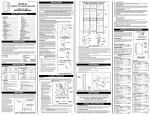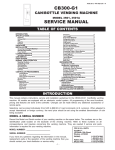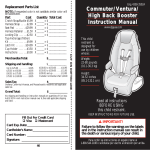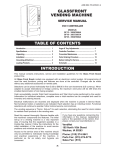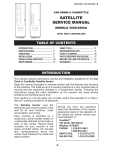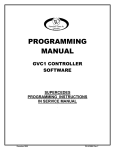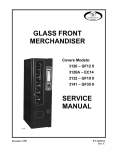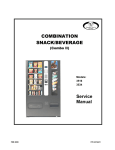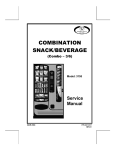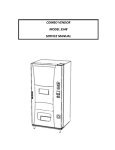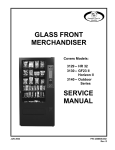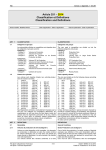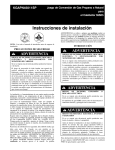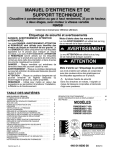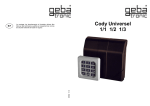Download CB700-G1 SERVICE MANUAL
Transcript
CB700-G1 1 2 3 4 5 6 7 8 9 * 0 # FEB 2007 • P/N 4215422 • C CAN/BOTTLE VENDING MACHINE MODEL 3502, 3502A SERVICE MANUAL A11615 TABLE OF CONTENTS INTRODUCTION ....................................................... 1 SPECIFICATIONS .................................................... 2 Fast Change ....................................................................... 8 Point of Sale Message ....................................................... 8 Target Temperature ........................................................... 8 Keypad Backlight ............................................................... 8 Drop Sensor ....................................................................... 8 Can/Bottle Configuration ................................................... 9 Space To Sales ................................................................... 9 Set Price by Selection ....................................................... 9 Set Price of Entire Machine .............................................. 9 Set Coupon Value .............................................................. 9 Set Token Value ................................................................. 9 Accounting Totals of Entire Machine ............................... 10 Accounting Totals by Selection ........................................ 9 Count Tube Fill ................................................................... 10 Test Single Motor ............................................................... 10 Test All Motors ................................................................... 10 Diagnostics ......................................................................... 10 Relay Test ........................................................................... 10 Electrical ................................................................................. 2 Refrigeration ........................................................................... 2 Size .......................................................................................... 2 Capacity ................................................................................... 2 Features ................................................................................... 2 UNPACKING ............................................................ 2 INSTALLATION ........................................................ 3 Grounding (Earthing) & Electrical ......................................... 3 Power Switch .......................................................................... 3 Door Switch ............................................................................. 3 Hinge & Door Removal ........................................................... 3 LOADING PRODUCTS ............................................. 4 Vend Rack .............................................................................. 4 Live Display ............................................................................. 6 REFRIGERATION .......................................................... 10 DROP SENSOR ........................................................ 6 NORMAL VEND OPERATION ................................. 6 Refrigeration Controls ................................................................. 10 Refrigeration Troubleshooting ................................................... 10 Compressor Will Not Start ................................................ 11 Compressor Trips On Overload ........................................ 11 Noisy or Vibrating Unit ...................................................... 11 Unit Short Cycles ............................................................... 11 Unit Operates Long or Continuously ................................ 11 Refrigerated Space Too Cold ............................................ 11 Refrigerated Space Too Warm .......................................... 12 Troubleshooting Circuits with Multi-Meter ................................ 12 Refrigeration Unit Removal ......................................................... 12 Stand-By Condition ................................................................ 6 Establishing Credit ................................................................. 6 Valid Selection ........................................................................ 7 Vend Sequence ....................................................................... 7 Product Delivery ..................................................................... 7 Sold Out ................................................................................... 7 Resetting Sold-Out Selections ............................................... 7 CONTROLLER PROGRAMMING ............................ 7 Control Board ......................................................................... 7 Sales Mode .............................................................................. 7 Current Temperature ......................................................... 7 Service Mode ........................................................................... 7 Dispense Coins .................................................................. 8 Motor Count ........................................................................ 8 Force Vend .......................................................................... 8 Bill Escrow .......................................................................... 8 Multi Vend ........................................................................... 8 Free Vend ............................................................................ 8 CARE & CLEANING ..................................................... 13 Cabinet Exterior ............................................................................ 13 Cabinet Interior ............................................................................. 13 Refrigeration System ................................................................... 14 ANTI-CHEAT INSTALLATION ..................................... 14 PARTS ORDERING PROCEDURE .............................. 15 BEFORE CALLING FOR SERVICE ............................. 15 SCHEMATIC .................................................................. 16 INTRODUCTION This manual contains instructions, service and installation guidelines for the CB700-GVC1 Can/Bottle vending machine. All models are equipped with an electronic control system. All programming of the vend functions, pricing and features are done at the controller. Changes can be made without any additional accessories or remote parts. Selections can be priced individually from $.05 to $99.95 in 5 cent increments (U.S. currency). When adapted to accept international or foreign currency, the maximum vend price will be 255 times the smallest denomination of coin being accepted. MODEL & SERIAL NUMBER Record the Model and Serial number of your vending machine on the space below. The numbers are on the identification plate located on the backside of the vending machine. Refer to these numbers on all correspondence and inquiries concerning this vending machine. They are needed if service and parts information is required for your vending machine. FOR U.S.A. UNITS: MODEL NUMBER: SERIAL NUMBER: If you have any questions regarding the information in the manual, replacement parts or the operation of the vending machine then you should contact your local distributor or service entity. -1- VendNet™ 165 North 10th Street Waukee, IA 50263 PHONE: PARTS FAX: SALES FAX: 1-515-274-3641 1-800-833-4411 1-515-987-4447 1-515-274-0390 SPECIFICATIONS ELECTRICAL Model Voltage Frequency Current REFRIGERATION 3502 3502A 115 VAC 230 VAC 60 Hz 50 Hz 9 Amps 5 Amps Unit Size SIZE 1/3 HP Hermetically Sealed Refrigerant R-134a Charge 8.5 Oz. CAPACITY Height 72 In (183 cm) Selections 12 Width 42 In (106 cm) Columns 14 Depth 33 In (84 cm) 12 Oz. Cans 50 per column, 700 total 20 Oz. Bottles 23 per column, 322 total Weight 750 Lbs. (340 kg) FEATURES • On-Board 4 Digit, 7-Segment, Ultra high intensity LED Display. • MDB (Multi Drop Bus) coin mechanism and bill validator interface. • Piezo "beeper" to provide audible feedback for key presses and control board activity. • No change or loss of program or memory because of power failure. • Multi Vend. • First-in first-out for all selections. • Motorized delivery, electronically controlled. • Impact sensor delivery system. • Dual Regulated Power Supplies for logic and motor control. • User friendly Service Mode. • Cash and Vend accountability. Information for individual selections or total machine can be compiled and used for inventory and ordering records. • Individual product pricing from free vend ($0.00) to $99.95 • Motor vend testing selection. UNPACKING This vending machine was thoroughly inspected before leaving the factory and the delivering carrier has accepted responsibility for this vending machine. Note any damage or irregularities at the time of delivery and report them to the carrier. Request a written inspection report from the claims inspector to file any claim for damage. File the claim with the carrier (not the manufacturer) within 15 days after receipt of the machine. Carefully remove outside packing material to avoid damage to the finish or exterior of the machine. Remove adhesive residue with denatured alcohol or common household vinegar. INSERT SCREWDRIVER IN SLOT AND TWIST Remove the Knock-Away Support by placing a spacer under the vending machine, insert a screwdriver or prying tool into the grove and split the wood in two. Discard the washer located on each side of the wooden supports. Turn the leveling screws as far in as possible. See Figure 1. USE A WOOD BLOCK TO PROP UP ONE SIDE A10673 FIGURE 1. REMOVING KNOCK-AWAY SUPPORTS -2- INSTALLATION Consult local, state and federal codes and regulations before installation of the vending machine. To minimize installation time and to avoid service problems due to improper installation, follow the instructions outlined in this manual. Position the vending machine in its place of operation no further than six feet from the power outlet or receptacle and check that the door will open fully without interference. Leave at least four inches of space between the back of the vending machine and any wall obstruction for proper air circulation. CAUTION: Do not block the vent openings in front or in the rear of the vending machine. Always allow free ventilation behind a bank installation so that exhaust air is not trapped. Failure to do so could result in refrigeration failure. Level the vending machine, making sure all levelers are touching the floor. The vending machine must be level for proper operation. If it is properly leveled, it should not "rock" or "teeter" on any of the levelers. When the vending machine is level, the door can be opened to any position and not move by itself. Try the door half closed, straight out and in a wide open position before deciding that the vending machine is level. Remove all shipping brackets, tape and inner packing material from the vending machine. Operating the vending machine without removing the tape and packing material 3-AMP BREAKER could result in damage to the vending machine. POWER GROUNDING (EARTHING) & ELECTRICAL SWITCH Prior to connecting the equipment, the integrity of the main electrical supply must be checked for correct polarity, voltage, (earth) ground and (amperage) circuit protection. The fuse or breaker protecting the circuit must be rated at 15 amps or greater.It is recommended that these checks be repeated at 6 months intervals with the routine safety electrical testing of the equipment itself. To correct negative voltage, amperage, polarity or ground (earth) checks, consult a qualified technician. A noise suppressor has been installed in this vending machine to compensate for any signal noise that could FIGURE 2. POWER SWITCH interfere with the normal operation of the control board. The vending machine must be grounded for noise suppressor to (POWER PANEL) work. ON A10674 WARNING: Do not use extension cords. POWER SWITCH A power switch is located on the power panel (bottom left area with door open), along with a 3 amp breaker. With the door open, this switch will shut off the light and controller, leaving evaporator fans running. See Figure 2. The 3 amp breaker is protection for the controller. DOOR SWITCH The vending machine has a door switch operated by the outer door. It is located in the lower right corner of the cabinet. When the door is closed, the switched is pushed in to the ON position, putting the vending machine in the Sales Mode. When the door is opened, the switch is forced to the OFF position allowing the vending machine to be put in Service Mode. DOOR SWITCH A11614 FIGURE 3. DOOR SWITCH LOWER HINGE PIN RETAINING SCREW To operate the machine with the door open, the door switch must be manually pulled out, placing it in an alternate ON position. HINGE & DOOR REMOVAL Removal of the upper hinge or the door from the lower hinge pin requires removal of the hinge pin retaining screws. See Figures 4 and 5. A10857 FIGURE 5. LOWER HINGE PIN -3- 1. Open the door to approximately straight out position. LOWER HINGE PIN 2. Remove upper and lower hinge pin retaining screws. RETAINING SCREW 3. Use wooden blocks to support the door. A second person is required to steady the door. Upper hinge may now be removed from the vending machine. 4. Lift door from lower hinge. Service as required. 5. Replace door on lower hinge. Support door on blocks. A second person is required to steady the door while the top hinge is installed. A10857 6. Reinstall the hinge pin retaining screw. FIGURE 5. LOWER HINGE PIN LOADING PRODUCTS VEND RACK IMPORTANT SUGGESTION: Load the front rack with products that sell faster. When loading, fill the rear selections first. This method makes it easier to load the rack. 1. Products featured in front door Live Display must match the products being loaded. 2. Funnel slides must be kept clean. Refer to Figure 7 for part names, locations and product orientation. 3. Refer to Figure 7. Product container bottoms must face towards the center of the rack as shown. Do not store bottles in "spare" space of the cabinet. The refrigeration unit could be damaged. A loading chart has been provided on the inner door to make it easier to keep track of what types of products have been loaded into the CB700-G1. Use a dry erase marker to avoid making a permanent mark. If refilling with the same product size into the same column, then load products into the columns. Skip steps 7 through 11. 4. 5. 6. 7. If a) loading for the first time, or b) changing a column to a different product size or c) to reset product cradle (motor) to correct position, then load one row of products in each column and test vend each column using real money. CAUTION 8. FIGURE 6. VEND RACK Do not load dented or damaged cans or bottles in the columns. Possible jams could occur. Add five (5) rows of products in each column to check product spacing. Products should have 1/4 to 1/2 inches of free space at the front or back of the columns. See Figure 7. See step 9. -4- THE VEND RACK HAS BEEN SET AT THE FACTORY FOR MOST 20 OZ BOTTLES OR 12 OZ CANS SEE STEP 9 TO VEND OTHER TYPES OF CONTAINERS BACK SPACER BACK SPACER BACK SPACER 1/4" TO 1/2" 1/4" TO 1/2" TYPICAL 20 OZ TYPICAL 20 OZ CENTER FILLER CENTER FILLER SINGLE DEPTH SETTING TYPICAL CONTOURED 10 OZ CENTER FILLER TYPICAL 12 OZ CAN TYPICAL 20 OZ TYPICAL 20 OZ DOUBLE DEPTH SETTING TYPICAL 12 OZ CAN 1/2" MAX 1/4" TO 1/2" 1/4" MIN LIFT UP LIFT UP PULL PULL DIMPLE MUST CLEAR SLOT OPENING SMALL SCREWDRIVER SLOT OPENING SLOT OPENING DIMPLE MUST CLEAR SLOT OPENING NOTCH MARKER LATCH STRIKER (LEFT SIDE) GATE ASSEMBLY (RIGHT SIDE) A10886 FIGURE 7. COLUMN DEPTH 9. VEND RACK ADJUSTMENTS: Adjust the back spacer, latch striker or gate assembly to achieve the required dimension. The Vend Rack has been factory set for most 20-oz. bottles or 12-oz. cans. There are a wide variety of water bottle sizes. Avoid vending containers that collapse on itself when stacked. Test vend before using. Call service for additional can/bottle vending information and suggestions. If vending 16.9-oz water bottles, remove Filler (4211816) shipped inside the Delivery Box and install it in the Vend Rack. Follow instructions on Filler decal. ADJUSTING THE BACK SPACER: Lift the back spacer and reposition it in the adjustment slots. Use notch markers as reference points to align it vertically. See Figure 7. ADJUSTING THE LATCH STRIKER AND GATE ASSEMBLY: Pull and lift up on the lower end of the gate assembly (or latch striker). Use a small screwdriver as a wedge to gently pry the dimple away from the slot opening. See Figure 7. Reposition them in the adjustment slots. Use notch markers as reference points to align it vertically. 10. If product spacing is correct, then test vend each column using real money. 11. Load the columns to full capacity. -5- LIVE DISPLAY Products featured in the front door Live Display must match the products being loaded. 1. Open the main cabinet door, then open the inner door. 2. Use a Phillips Head screwdriver to loosen the 6 screws holding Display Cover. Slide the cover up, lift it out and carefully set it aside. 3. Place product containers on the shelves of the Live Display. 4. Reinstall the Display Cover. SCREWS 6 PLACES PRODUCT PRODUCT A11619 LIVE DISPLAY COVER A11618 FIGURE 8. LIVE DISPLAY COVER FIGURE 9. PRODUCTS IN LIVE DISPLAY DROP SENSOR A drop (vibration) sensor on the delivery chute detects if a product has been vended after a selection is made. The control board located on the back of the main door controls the sensor sensitivity. The drop sensor sensitivity is factory calibrated and should not need adjustment. Please refer to DROP SENSOR instructions in the CONTROLLER PROGRAMMING section of this manual to restore the drop sensor sensitivity to factory settings. NORMAL VEND OPERATION 1. STAND-BY CONDITION When the control board is in Sales Mode the display will show "ICE COLd" or the amount of credit. If a customer presses a selection before establishing a credit, the vend price for that selection will display signaling the customer that more money is needed for that selection. 2. ESTABLISHING CREDIT Feeding coins into the coin mechanism or bills into the bill validator results in the display of the corresponding credit value. The coin mechanism or bill validator will accept money until the highest vend price has been reached or exceeded. At this point a credit has been set up through the control board that will enable a vend for any selection less than or equal to the established credit. -6- 3. VALID SELECTION Making a selection on the keypad causes the control board to determine if a vend motor is available and if enough credit is established. If both conditions are met then a vend is initiated. 4. VEND SEQUENCE The control board then distributes 24 volts DC through the door and cabinet wiring harnesses and to the coil of the selected product cradle motor. At the same time, the display will flash. This indicates to the customer that a vend is in progress. As the product cradle motor receives power, it will turn the product cradle attempting to vend a can or bottle. 5. PRODUCT DELIVERY As the can or bottle drops onto the product delivery chute, impact or vibration allows the drop sensor to send a low voltage signal to the control board indicating that the product has been vended. After receiving the drop sensor signal, the control board will recognize how the vending machine is programmed and responds accordingly. Refer to CAN/BOTTLE menu section on page 2 for additional features. 6. SOLD OUT The display will blink to show the vend process of each selection. If a product drop is not detected in 10 to 12 seconds, "MAKE ANOTHER SELECTION" light turns on. This condition may be due one of the the following: • Column is actually sold out. • Selected column is jammed. • Wrong selection number. • Drop Sensor does not detect product drop which may be an indication of a faulty Drop Sensor. Perform a DIAGNOSTICS routine (page 2) and a test vend. If "MAKE ANOTHER SELECTION" indicator light is turn is on, the customer may make a different selection or receive a refund by pressing the coin return lever. If the machine is set for forced purchase, the customer must make an initial selection. If the selection is sold out, a full refund or an alternate selection will be allowed. 7. RESETTING SOLD-OUT SELECTIONS Opening the machine door activates the door switch and will clear a sold out condition. The controller will not attempt a vend until this is done. Pressing a selection button will only initiate the "Sold Out" display. CONTROLLER PROGRAMMING CONTROL BOARD This vending machine has a GVC1 control board that is connected to product cradle motors. It is also connected to a drop sensor (impact vibration) for delivery detection. Open the main door and then open the inner door. The control board is located on the back of the main door (top middle). See Figure 11. SALES MODE FIGURE 10. DISPLAY The vending machine defaults to sales mode when it is turned on. While it is in sales mode, the display will show "ICE COLd". If there is credit to the customer, it will display the amount of credit. CURRENT TEMPERATURE STEP 1 Press 0 to view the temperature sensor reading. SERVICE MODE BUTTON DISPLAY 36F POWER ON LIGHT SERVICE MODE Pressing the service mode button while the vending machine is in sales mode will activate service mode. It will display the number of working motors. While in service mode, the control board will automatically revert to sales mode after one (1) minute if a keypad button is not pressed. DEX JACK (OPTION) NOTE: Always watch display readout after pressing the Service Mode button or keypad button. A11545 -7- FIGURE 11. SERVICE MODE BUTTON DISPENSE COINS FORCE VEND Manually dispense coins from the coin mechanism. STEP 1 2 3 Press Service Mode Button Press 1 . . 4 5 6 Press 2 to dispense quarters (10¢). Press 3 to dispense nickels (5¢). Press twice to exit. Press 1 to dispense quarters (25¢). This feature would require the customer to purchase an item from the vending machine once credit equal to or greater than the highest selection price has been deposited. DISPLAY 14 Coin .25 .10 .05 ICE COLd STEP MOTOR COUNT Displays the total count of working motors. STEP 1 Press Service Mode Button 2 3 Press 2 and wait a moment. Press twice to exit. . DISPLAY 14 14 ICE COLd STEP Press Service Mode Button Press 3 . 3 4 Press 3 . Press 3 to toggle ON or OFF. 5 6 Press # to save. Press three times to exit. . Note: NULn = NO (OFF), NULy = YES (ON). DISPLAY 14 OPtn NULn NULy ICE COLd Press Service Mode Button Press 3 . 3 Press 5 . Press 5 to toggle ON or OFF. . Note: FChn = NO (OFF), FChy = YES (ON). three times to exit. STEP Press Service Mode Button Press 3 . DISPLAY 14 OPtn FChn FChy ICE COLd three times to exit. Press Service Mode Button Press 3 . Press 2 . . DISPLAY 14 OPtn ESCy Press 2 to toggle ON or OFF. ESCn Note: ESCn = NO (OFF), ESCy = YES (ON). 5 Press # to save. 6 Press ICE COLd three times to exit. . DISPLAY 14 OPtn 36F Press 8 repeatedly until 36F is displayed. Press # to save. three times to exit. 2 3 Press Service Mode Button Press 3 . Press 4 . 4 Press 4 to toggle ON or OFF. 5 Press # to save. 6 Press . DISPLAY 14 OPtn FrEn FrEy Note: FrEn = NO (OFF), FrEy = YES (ON). ICE COLd three times to exit. STEP ICE COLd 1 2 Press Service Mode Button Press 3 . . 3 4 Press 7 . Press 7 to toggle ON or OFF. 5 Press # to save. 6 Press DISPLAY 14 OPtn POSy POSn Note: POSn = NO (OFF), POSy = YES (ON). ICE COLd three times to exit. KEYPAD BACKLIGHT This menu controls the intensity level of the keypad backlight. STEP Restores the Drop Sensor sensitivity to factory calibrated setting. STEP 3 4 5 6 Press For Can/Bottle Machines Only. Turns OFF (or ON) the default flashing display message. DROP SENSOR 1 2 6 POINT OF SALE MESSAGE ICE COLd Press 8 . Press Press # to save. 1 Restores the target temperature to factory setting. 5 6 5 FrcY Note: Frcn = NO (OFF), Frcy = YES (ON). FREE VEND TARGET TEMPERATURE 4 Press 1 to toggle ON or OFF. STEP 1 2 2 3 4 DISPLAY 14 OPtn Frcn This feature allows the customer to vend any selection item for free. STEP 1 Press 1 . 4 Allows the vending machine to give change immediately after the customer makes a selection. If Fast Change is ON, it will override the Multi Vend feature. Press 3 1 2 3 FAST CHANGE 6 Press 3 . STEP 1 2 Press # to save. 2 . This feature will hold a bill in escrow (mechanically) until either a vend is performed or the return credit lever is pressed. This prevents the customer from using the vending machine as a bill changer. Multi Vend feature will hold the change (credit), allowing the customer to make more than one vend provided there is sufficient credit remaining. 5 Press Service Mode Button BILL ESCROW MULTI VEND 4 1 Press Service Mode Button . Press 3 . Press 0 to view current setting. Press 0 repeatedly until "drP1 " is displayed. Press # to save. Press three times to exit. 1 DISPLAY 14 OPtn drP1 ICE COLd 2 3 4 -8- Press Service Mode Button Press 3 . . Press 9 to view the setting. Press 9 to again and again to change setting. Note: bL 0=OFF, bl 1= Low, bl 2=Med, bl 3=High, bL 4=Max. 5 Press # to save. 6 Press three times to exit. DISPLAY 14 OPtn bL 3 bL 0 ICE COLd CAN/BOTTLE CONFIGURATION SPACE TO SALES CAn - Can setting is normally used with double-depth loading of cans to double the product capacity of that selection. During a vend, the product cradle stops rotating as soon as the drop sensor detects a vend. This is to prevent double vending. bott - Bottle setting is normally used with single-depth loading of bottles. This setting allows the product cradle to continue rotating a few more seconds so that it is positioned closer to the loading zone. This reduces the customer's waiting time when the product cradle is activated for the next vend. The controller has been configured to operate as a CB700 can/bottle vending machine and all selections are set to vend cans. Follow the steps below to restore the controller to a can vending machine, or to set all or some selections to vend bottles. STEP 1 2 Press Service Mode Button Press 4 . . 3 To set all selections press 3 then go to step 4. To set a selection, go to step 6. 4 Press 1 to toggle the setting until CAn (or bott ) is displayed. Do not select SnAc. Note: CAn = Can, bott = bottle, SnAc = Snack. 5 Press # to save setting then go to step 6 to set selections or go to step 11 to exit. 6 To set a selection, press 1 then wait a moment. 7 8 Press selection number on keypad. Press 1 to toggle the setting between CAn (can) or bott (bottle). 9 Press # to save the setting. 10 Go to step 7 to set more selections. 11 Press StSY - Space to Sales is factory set to on (Y = ON) for the CB700 vending machine. This means that columns 1-2 are assigned to selection 10 and columns 3-4 are for selection 11. STEP 1 2 3 4 5 DISPLAY 14 CbS ALL CAn DISPLAY 14 CbS StSn Press Service Mode Button . Press 4 . To restore Space to Sales configuration press 7 . Press 7 to toggle the setting to StSY. StSY Note: StSn = Space to Sales OFF, StSY = Space to Sales ON. Press # to save setting. 10 Press ICE COLd three times to exit. SET PRICE BY SELECTION CAn CbS ALL Each -CAn Press Service Mode Button Press 5 . 5 Enter new price of selection. To erase, press then go to step 5. 6 bott -- DISPLAY 14 Prc EAch -.75 STEP 1 2 3 4 . Press 1 and wait a moment. Press selection number on keypad. 7 8 Press # to accept price. 9 Press Repeat steps 4 thru 7 for other selections. ICE COLd four times to exit. ICE COLd three times to exit. SET TOKEN VALUE STEP SET PRICE OF ENTIRE MACHINE STEP 1 2 3 Press Service Mode Button . Press 5 . Press 3 and wait a moment. 4 Enter new price on keypad. 5 6 To erase, press then repeat step 4. To accept, press # . 7 Press DISPLAY 14 Prc ALL .75 ICE COLd four times to exit. DISPLAY 14 Prc 1 2 3 Press Service Mode Button Press 5 . Press 5 . . 4 Press 1 thru 5 to select token number. 5 6 Press # to view or set price/value of token. Enter new price/value of token. 7 8 To erase press 9 Repeat steps 4 thru 8 to set price values of other tokens. thn1 1.00 and repeat step 6. Press # to accept token price. 10 Press thnl ICE COLd three times to exit. ACCOUNTING SET COUPON VALUE STEP STEP DISPLAY 14 Prc CPn1 1 2 3 Press Service Mode Button Press 5 . Press 4 . 4 5 Press 1 thru 5 to select coupon number. Press # to view or set price (value) of coupon. 6 Enter new price (value) of coupon. 7 To erase, press 8 9 Press # to accept coupon price. CPn1 Repeat steps 4 thru 8 to set price values of other coupons. 10 Press . TOTALS BY SELECTION 1.00 and repeat step 6. three times to exit. ICE COLd -9- Press Service Mode Button . 1 2 Press 6 . 3 4 5 Press 1 . Press the selection number. Press 1 for total non-resettable vend count. 6 Press 2 for total non-resettable cash value. 7 8 Press 3 for total resettable vend count. Press 4 for total resettable cash value. 9 Press 5 # to clear the resettable counters. 10 Press and go to step 4 for other selections. 11 Press four times to exit. DISPLAY 14 Acct EACH -0 0.00 0 0.00 Clr? Clrd Acct ICE COLd ACCOUNTING TOTALS OF ENTIRE MACHINE STEP 1 Press Service Mode Button 2 Press 6 . Press 3 . 3 4 5 . Press 1 for total non-resettable vend count. Press 2 for total non-resettable cash value. 6 7 Press 3 for total resettable vend count. Press 4 for total resettable cash value. 8 Press 5 9 Press # to clear the resettable counters. four times to exit. TEST SINGLE MOTOR STEP DISPLAY 14 Acct ALL 0 0.00 0 0.00 Clr? Clrd ICE COLd 1 2 3 4 5 The coin mechanism will keep track of the exact number of each coin as coins are added through the coin insert. Denominations do not have to be added in order. The control board will keep track of each coin as it is paid out. 4 Press Service Mode Button . Press 7 . Add 5 coins of each through the coin insert: 25¢, 10¢ and 5¢. Total coin value is displayed. Press # to save. 5 Press 1 2 3 twice to exit. 1 2 3 Press Service Mode Button . Press 9 . Motor selection number will display while it is being tested. Press twice to stop test and exit. Press Service Mode Button . Press 0 . Press 1 to perform a self diagnostic test. 4 Press 1 2 .25 3 4 ICE COLd STEP 1 2 3 three times to exit. RELAY TEST DISPLAY 14 tUFL TEST ALL MOTORS STEP Press selection number on keypad. Repeat step 3 to test other selections. Press twice to stop test and exit. DIAGNOSTICS COIN TUBE FILL STEP Press Service Mode Button . Press 8 and wait a moment. 5 STEP Press Service Mode Button . Press 0 . Press 2 . Press 1 to display compressor relay1 status. Press 1 to turn ON the compressor relay. Press 1 again to turn it OFF. DISPLAY 14 SLct -ICE COLd DISPLAY 14 dIAG tESt ICE COLd DISPLAY 14 diaG rLY rL1o rL1c CAUTION: Once the compressor has been turned off, wait 3 minutes before turning it on again to prevent possible damage to the compressor. Note: rL1o = relay1 switch contacts open (OFF). rL1c = relay1 switch contacts closed (ON). DISPLAY 14 ALL 6 ICE COLd Press 4 times to exit. ICE COLd REFRIGERATION REFRIGERATION CONTROLS The target temperature setting for the refrigeration system has been preset at the factory. Refer to TARGET TEMPERATURE in the CONTROLLER PROGRAMMING section (page 1) of this manual. If setting up for the first time, please allow sufficient time for the refrigeration system to cool the produczts. WARNING: Colder setting does not cool drinks faster and may cause drinks to freeze. REFRIGERATION TROUBLESHOOTING CAUTION: Do not place any object in the evaporator assembly area or inside the cabinet area that will block the airflow because this may damage the refrigeration system, which may void the refrigeration warranty. CAUTION: Breaking the refrigerant joints or seals on the system voids the unit warranty. Failure to keep the condenser coil clean and free of dirt, dust and other similar debris voids the unit warranty. If the refrigeration unit is turned off or the power is interrupted or the door is opened then the refrigeration unit will not start for at least three (3) minutes regardless of the temperature. This is done to prevent damage to the refrigeration unit. Know and understand how to service the unit and how it operates. Units may vary but the operation is basically the same. Never guess at the problem. Find the symptom before attempting any repair. NOTE: 90% of refrigeration problems are electrical. Unauthorized work done to the sealed hermetic system will void the warranty. The sealed hermetic system is not to be worked on outside the Factory Service Center. The three (3) things that can go wrong with a sealed system - 10 - 1. Low Charge - usually caused by leaks. Look for oil around seals and welds. Unit will not cool properly. The capillary tube will be frosted before it enters the evaporator inlet tube. DO NOT STORE PRODUCTS HERE KEEP AREA OPEN FOR PROPER AIRFLOW AND PROPER VENDING OPERATION 2. Restriction in System (unit frosts, then melts) - not cooling properly. 3. Bad valves - unit does not cool properly or noisy compressor. FIGURE 12. REFRIGERATION COMPRESSOR WILL NOT START a. b. c. d. e. f. Vending machine not plugged in. Tripped breaker or blown fuse. Faulty wall outlet. Short or tear in power cord. Improper wiring. Low voltage: 5% below. Check the power source with the Multi-Meter. g. Overload defective: Trips too fast. Check overload with the Multi-Meter. h. Start relay defective. Check start relay with the MultiMeter. i. Compressor has open windings. Check compressor windings with a Multi-Meter. j. Defective thermistor. COMPRESSOR TRIPS ON OVERLOAD a. Improper voltage: 5-10% above, 5% below. Check power source with Multi-Meter. b. Overload defective: Trips too fast. Check overload with Multi-Meter. c. Relay defective: Won't open after starting. Check relay with Multi-Meter. d. Compressor has shorted windings: Check compressor windings with Multi-Meter. e. Short in other component: Isolate and eliminate each electrical component until short is found. f. Compressor is too hot. • Dirty condenser. • Faulty condenser motor or blade. • Restricted airflow. CAUTION: Condenser must be kept clean of dirt and debris to allow for proper air circulation. NOISY OR VIBRATING UNIT a. Components rubbing or touching each other. • Check fan blades and motor. • Loose shrouds and harness. • Copper tubing. • Loose or unsecured parts. b. Worn or aged grommets. c. Compressor • Bad valves. • Slugging. • Bad windings (see Figure 13) • Low voltage. UNIT SHORT CYCLES • Temperature setting too warm. See Refrigeration Controls section in this manual. UNIT OPERATES LONG OR CONTINUOUSLY a. Air flow restricted: • Faulty evaporator motor or blades causing coils to ice over. • Loose connections on evaporator motor. (One motor not running). • Air flow blocked by product in front of evaporator or air duct t openings. b. Gasket leak around main door. c. Gasket leak around delivery door. d. Excessive load: After loading, unit will run longer to pull out excessive heat from product. e. Shortage of refrigerant or restriction. REFRIGERATED SPACE TOO COLD • Target temperature set too cold. - 11 - REFRIGERATED SPACE TOO WARM a. Target temperature set too warm. b. Restricted evaporator space. • Evaporator motor or blades faulty, causing the coils to ice over the evaporator. • Condenser airflow restricted. ~ Plugged or dirty condenser. ~ Condenser motor or blades bad. ~ Blade stuck. • Condensing space restricted. ~ Unit placed too close to a wall. • Compressor - bad valves. ~ Cap tube will start frosting 8 to 10 inches past evaporator connection tube. ~ Check for oil around brazed connections. • Leak around delivery door gasket. TROUBLESHOOTING CIRCUITS WITH MULTI-METER a. Check the power source. Use voltage section of the MultiMeter. Should measure within 5-10% above, 5% below. b. Check overload. Note: Power must be off and fan circuit open. Using the resistance section of the Multi-Meter, check terminals 1 and 3 for continuity. If no continuity is measured (infinity), overload may be tripped. Wait 10 minutes and try again. If still no continuity, overload is defective. WARNING: c. Check relay. See Figure 13 shown below. Unscrew lead terminals and remove relay from compressor. Keep relay upright. d. Check terminals 1 and S, or L and S with the Multi-Meter. Replace relay if continuity exists. e. Check compressor windings. See Figure 13 shown below. f. Check winding resistance with the Multi-Meter. If readings are not within 2 Ohms the compressor is faulty. Wiring diagram must be followed as shown. Wrong wiring can cause serious electrical hazard and potential damage or rupture component electrical parts. WINDING RESISTANCE Approximate resistance reading across terminals - use RXI scale. COMMON to START: COMMON to RUN: RUN to START: COMMON to SHELL: 1 L2 L1 GND GROUND CONDUCTOR 8 Ohms C 3 OVERLOAD CONDENSOR FAN MOTOR RELAY R M 1.2 Ohms COMMON 9 Ohms No Continuity L S S RUN START A10115 FIGURE 13. COMPRESSOR SCHEMATIC REFRIGERATION UNIT REMOVAL The refrigeration unit is a hermetically sealed and completely self-contained modular unit charged with ozone friendly R-134a refrigerant. The complete refrigeration unit can be removed if there is a service problem. WARNING: Disconnect power before servicing. 1. Unplug the CB700-G1 power cord from the electrical wall outlet. 2. Remove and save the 3 screws holding the Hopper. See Figure 14. Carefully remove the Hopper and set it on the right side while avoiding not to damage the Drop Sensor or its cable harness. Remove and save the Condenser Filler Cover and the 4 screws. Refer to Figure 15. Remove and save the Refrigeration Line Cover and the 2 screws. Remove the save the sealant. 3. 4. 5. 6. 7. 8. REMOVE & SAVE 3 SCREWS Remove and save the 4 screws screws located on the front (bottom and right) of the condenser assembly. Remove and save the 4 screws of the Power Panel. Move the Power Panel to the left side. A11617 FIGURE 14. REMOVE HOPPER SCREWS - 12 - REMOVE CLAMP SCREWS & CLAMPS. MOVE TEMPERATURE SENSOR TO THE SIDE. REMOVE EVAPORATOR SCREWS (7 PLACES). PULL ON EVAPORATOR UNIT & REFRIGERATION UNIT AT THE SAME TIME. REMOVE SEALANT COVER SCREWS. REMOVE BOTH COVERS. REMOVE HOPPER BRACKET SCREWS (2 PLACES). REMOVE BRACKET. REMOVE PANEL SCREWS (6 PLACES). MOVE PANEL ASIDE. A11616 SET HOPPER TO RIGHT SIDE. REMOVE REFRIGERATION SCREWS (4 PLACES). PULL REFRIGERATION UNIT & EVAPORATOR UNIT AT THE SAME TIME. FIGURE 15. SET HOPPER ASIDE & REMOVE SCREWS 9. Remove and save the two (2) screws holding the Hopper Bracket in place. Remove and save the Hopper Bracket. 10. Remove the screws and clamps that attach the Temperature Sensor to the Evaporator. Move the sensor to the right side. 11. Remove and save the three (3) screws that attach the Evaporator to the Air Duct. 12. Carefully unplug and move wire harness and cables out of the way of the Refrigeration Unit. 13. Grip the front lip of the Condenser base and the Evaporator base and pull out at the same time. See Figure 15. 14. To reinstall the refrigeration unit, reverse the steps. CARE & CLEANING WARNING: ALWAYS DISCONNECT POWER BEFORE CLEANING. CABINET EXTERIOR Wash with a mild detergent and water, then rinse and dry thoroughly. Polish occasionally with a quality car wax. Plastic exterior parts may be cleaned with a quality plastic cleaner. CABINET INTERIOR CAUTION: DO NOT GET CLEANING SOLUTION ON ELECTRICAL COMPONENTS. Wash with a mild detergent and water, then rise and dry thoroughly. Including baking soda or ammonia in the cleaning solution may eliminate odors. Plastic parts may be cleaned with a quality plastic cleaner. Remove and clean Condensate Drain Hose to eliminate any deposits that may restrict condensate water flow. Vend mechanism must be kept clean. Any build-up of syrup deposits can cause the mechanism to malfunction. Use soap and water with great care so as not to get water into the electrical components. To insure proper vending keep delivery slide area free of dirt and sticky substances. - 13 - REFRIGERATION SYSTEM CLEAN REFRIGERATION INTAKE SCREEN - Remove screen and clean dust and debris from screen using a soft bristle brush or a vacuum cleaner. CLEAN CONDENSER COIL & REAR EXHAUST SCREEN - Remove the Cover Assembly and clean the condenser coil of the refrigeration unit using a soft bristle brush or vacuum cleaner. Pull the refrigeration unit and clean the rear exhaust screen of dirt and debris. Do not block the evaporator or any area of the airflow with product or supplies. ANTI-CHEAT INSTALLATION WARNING: Disconnect electrical power to avoid electrical shock when performing service. Do not remove electrical components or parts without first unplugging the power cord from the power source. 1. Unlock and open the vending machine Front Door. Open the Inner Door by separating it from the Front Door. 2. Find the Delivery Box on the bottom right corner of the Front Door as viewed from behind the Front Door. Remove the Delivery Box from the Front Door by removing the mounting nuts on the right, bottom and left sides of the Delivery Box. See Figure 17. NUT NUT LEFT VIEW DELIVERY BOX RIGHT VIEW NUT BOTTOM VIEW FIGURE 17. REMOVE THE DELIVERY BOX 3. Remove the four (4) nuts holding the Delivery Bezel and save them for step 4. Insert the Anti-Cheat through the Delivery Bezel rectangular hole. See Figure 18. 4. Mount the Anti-Cheat slotted mounting holes over the mounting bolts of the door as shown in Figure 19. Reinstall the nuts saved from step 3 and tighten them. 5. Reinstall the Delivery Box. 6. Close the Inner Door to the Front Door. Plug the machine's power cord to the wall outlet and turn on the power. 7. Close the Front Door and perform test vends. FIGURE 18. ANTI-CHEAT (FRONT VIEW) - 14 - FIGURE 19. ANTI-CHEAT (REAR VIEW) PARTS ORDERING PROCEDURE PLEASE HAVE THE FOLLOWING INFORMATION: • • The model number and serial number of the vending machine. • • Correct part number and description from the • pertinent part and/or parts manual. • If you do not have the correct parts manual, go • online to www.vendnetusa.com or contact VendNet™ and we will provide a copy for you. • Note: Unless specified otherwise, when "right" or "left" are used as a description in a part name, it is defined to mean that the person is facing the vending machine with the door closed. Shipping address. Address where the invoice should be sent. The number of parts required. Any special shipping instructions. Desired carrier: air or air special, truck, parcel post or rail. If ordering by mail, need signature and date. If a purchase order number is used, be sure that it is visible and legible. PARTS ORDER OPTIONS: • Go online to www.vendnetusa.com. Browse the parts manuals. Place a secured order online using your credit card or Vendnet™ account. • Phone: USA & Canada ................. (888) 259-9965 International ...................... (515) 274-3641 • Email: [email protected]. Please note that this is not as secured as playing an order online. • Fax Order: ......................... (515) 274-5775 • Mail Order: VendNet™ 165 North 10th Street Waukee, IA 50263 USA BEFORE CALLING FOR SERVICE PLEASE CHECK THE FOLLOWING: • Does your vending machine have at least 4" of clear air space behind it? • If the power is turned on at the fuse box, is the vending machine the only thing that doesn't work? • Is the vending machine plugged directly into the outlet? WARNING: Do not use extension cords. Extension cords cause problems. • Is the evaporator coil free of dust and dirt? • Is the condenser coil free of dust and dirt? • Is the compressor free of dust? A blanket of dust can prevent the compressor from cooling off between workouts. • Is the circuit breaker at the fuse box reset? • Are evaporator lines running? Take a sheet of paper approximately 4" x 5" in size. Place the paper in front of the evaporator coil and see if the evaporator fans will draw the paper to the coil. • Is the condenser fan running? Fold a sheet of 81/2" x 1" paper in half. Place the paper in front of the condenser coils and see if it draws the paper to it. • Is the shelf in front of the evaporator coil clear? There must be no tools or other air restricting items. • Is the cold control set between 0 and 2? NOTE: Setting the cold control at a colder temperature does not accelerate cooling of product and may cause product to freeze. TO CALL FOR SERVICE • Have model number and serial number. • Call phone number listed below. VendNet™ 165 North 10th Street Waukee, IA 50263 United States of America The contents of this publication are presented for informational purposes only, and while every effort has been made to ensure their accuracy, they are not to be construed as warranties or guarantees, express or implied, regarding the products or services prescribed herein or their use or applicability. We reserve the right to modify or improve the designs or specifications of such products at any time without notice. - 15 - NEUTRAL (RIBBED) COMPRESSOR RELAY F OVERLOAD S M - 16 - M 6 5 4 3 2 6 5 4 3 2 7 6 5 4 3 2 7 6 5 4 3 2 NC NC 1 8 8 J1 9 9 NC 1 10 10 NC J2 11 11 KEY 12 12 NC DIODE BOARD 2 1 7 7 J1 8 8 1 9 9 J2 11 10 10 12 11 12 DIODE BOARD 1 C NC KEY START RELAY S COMPRESSOR MOTOR 3 2 EVAPORATOR FAN 2 STARTING CAPACITOR 1 CONDENSOR FAN BLK-WHT F 1 SMOOTH (HOT) WHT-BLK 4214684 CAB.TEMP. SENSOR KEY NC NC NC NC NC NC KEY YEL-BLU DOOR SW 4214800 COMPRESSOR RELAY CABLE YEL-BLU PNK-RED PNK-BLK YEL-ORG PNK-RED PNK-BLK 4214728 SENSOR/RELAY HARNESS GRN YEL-ORG DEX OPTION CB700-GI SCHEMATIC SCHEMATIC
















